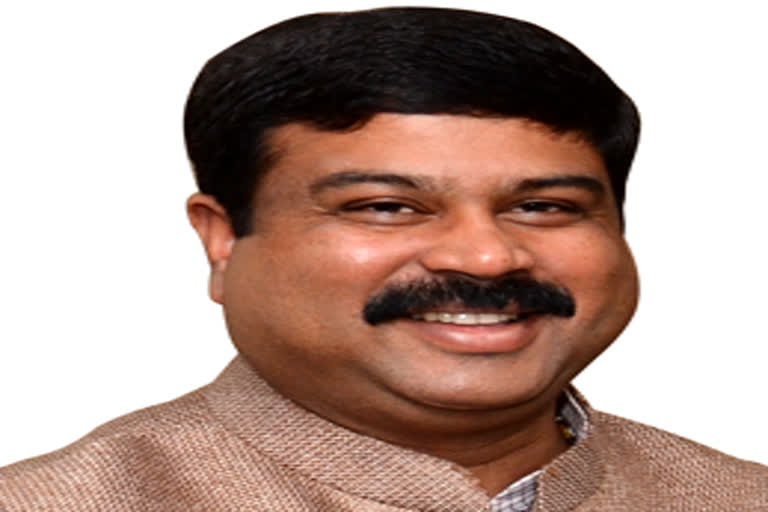New Delhi: India, the world's third-biggest oil importer, is exploring storing crude oil in the US and other commercially viable locations to hedge its supply risks, Oil Minister Dharmendra Pradhan said on Tuesday.
Also, the country has tied up long-term crude oil supplies from the US, Russia and Angola to diversify its import basket beyond its traditional suppliers in the volatile Middle-East.
Speaking at a conference on the 'Energy Security Towards Atmanirbhar Bharat', he said India is now importing crude oil from over 30 countries, including from Africa, North and South America as well as Southeast Asia.
"We are also exploring overseas crude storage facilities in the US and other commercially viable locations," he said.
India and the US had on July 17 signed a preliminary agreement for cooperating on emergency crude oil reserves, including the possibility of India storing oil in the US emergency stockpile.
The nation currently stores 5.33 million tonnes (about 38 million barrels) of crude oil in underground storages at three locations on the east and west coast, hardly enough to meet its 9.5 days needs.
The International Energy Agency (IEA) prescribes its members to have at least 90 days of stock in the strategic reserves.
India has been looking to expand the storage capacity by another 6.5 million tonnes Chandikol in Odisha and Padur in Karnataka and is also exploring the possibility of hiring storage in the US to stock some oil that can be used in times of extreme price volatility or supply disruption.
The nation is as much as 85 per cent dependent on imports to meet its oil needs. It bought 101.4 million tonnes of crude oil from overseas during April 2019 to March 2020 - two-third of these coming from the Middle East countries such as Iraq and Saudi Arabia.
"New long-term contracts have been entered into by our companies with their counterparts in the US, Russia and Angola," he said.
Read more: BPCL's Mozambique block acquisition under scanner
Also, the import of gas (in its liquid form or LNG) has been diversified from traditional supplier Qatar to the US, Australia and Russia, he said.
"With the significant demand contraction globally, the hydrocarbon supplies are relatively less of a concern," he said.
Pradhan said filling existing underground strategic storages using low priced crude oil in April and May helped save over Rs 5,000 crore.
"To further improve energy security in the hydrocarbons sector, we are gradually improving crude and petroleum products storage capacity from existing 74 days of national consumption to 90 days," he said.
India, he said, has enhanced its engagement with key global energy players, and firmed up of strategic and comprehensive energy engagements with producing countries such Russia, the US, Saudi Arabia and UAE on one hand, and close engagement with consuming countries such as Japan and South Korea on the other.
Pradhan said the nation had sufficient supplies of crude oil and liquefied natural gas (LNG) at the height of geopolitical tensions last year.
On the pricing of crude oil, he said India has been advocating a responsible and affordable pricing mechanism.
"Our five-pronged strategy to reduce crude oil import dependency including increasing domestic oil and gas production, promoting biofuels and renewables, energy conservation and energy efficiency, improvement in refinery processes and demand substitution, is making an impact," he said. "We still have more room to cover."
Pradhan said the existing energy frameworks are already witnessing unprecedented transformation due to the pandemic.
"What is the nature of the energy security infrastructure post-COVID-19 will squarely depend on how each country handles the current challenges in their national domain, and also in consort with the global energy community," he said.
COVID-19 led to the erosion of almost a third of global energy demand, triggered unprecedented oil price volatilities with significant geopolitical implications, delayed or stalled investments and projects in the energy sector, and created uncertainties over the employment prospects of millions of people associated with the sector.
"In an energy interdependent world, India cannot be immune to these momentous changes globally," he said.
India, as the world's third-largest consumer of energy, has not only been impacted but could potentially define the way global energy trends would emerge.
While oil gas sector was significantly affected in the initial stages of COVID-19, significant restoration of consumption of several petroleum products has been witnessed since July onwards.
"It is not surprising that India is estimated to account for 35 per cent of the increase in global primary energy consumption up to 2050. With over 16 per cent of the global population, India currently uses only 6 per cent of the world's primary energy.
"With the per capita consumption of energy still one-third of the global average, India will have to continue to develop all possible energy sources to meet this energy deficit," he said.
Oil PSUs are spending Rs 1.2 lakh crore on 8,363 projects during the current fiscal to boost economic activity in the pandemic-hit economy, he said.
(PTI Report)



